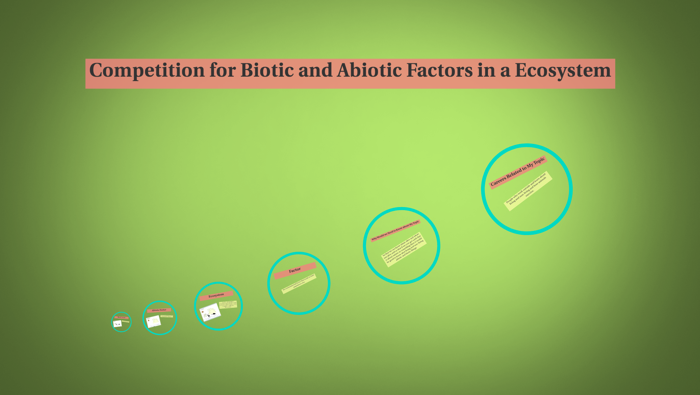The Role Of Abiotic And Biotic Factors In Species Competition

The Role Of Abiotic And Biotic Factors In Species Competition. Discover more detailed and exciting information on our website. Click the link below to start your adventure: Visit Best Website. Don't miss out!
Table of Contents
The Role of Abiotic and Biotic Factors in Species Competition: A Deep Dive
Species competition, the struggle between organisms for limited resources, is a fundamental ecological process shaping biodiversity and ecosystem dynamics. Understanding this intricate dance requires examining the influence of both abiotic and biotic factors – the non-living and living components of an environment, respectively. This article delves into the complex interplay of these factors, exploring how they shape competitive outcomes and drive evolutionary adaptations.
What are Abiotic and Biotic Factors?
Before exploring their roles in species competition, let's define these key terms:
-
Abiotic Factors: These are the non-living aspects of the environment that influence organisms. Examples include:
- Temperature: Extreme temperatures can limit species distribution and influence competitive ability. Species adapted to specific temperature ranges will outcompete others outside their optimal range.
- Water Availability: Access to water is crucial. Drought conditions can intensify competition for limited water resources, favoring drought-resistant species.
- Soil Nutrients: Nutrient availability in soil significantly impacts plant growth and competition. Nutrient-rich soils can support more diverse and abundant plant communities.
- Sunlight: Sunlight is essential for photosynthesis. Plants competing for sunlight in dense forests will develop strategies like taller growth or broader leaves.
- pH levels: Soil and water pH influence nutrient availability and can create selective pressures, favoring species adapted to specific pH ranges.
-
Biotic Factors: These are the living components of the environment impacting species interactions. Key biotic factors influencing competition include:
- Predation: Predators can influence competitive outcomes by selectively removing dominant competitors, thereby allowing less competitive species to thrive. This is known as apparent competition.
- Disease: Disease outbreaks can differentially affect species, weakening some competitors and giving others an advantage. This can lead to significant shifts in community composition.
- Herbivory: Herbivores can affect plant competition by selectively consuming certain plant species, altering the balance of plant communities.
- Competition itself: Direct competition for resources like food, space, and mates is a primary biotic factor driving species interactions. This can lead to competitive exclusion or niche partitioning.
- Symbiosis: Mutualistic or commensal relationships can indirectly impact competition. For example, a plant benefiting from a mycorrhizal fungus may outcompete plants lacking this symbiotic relationship.
How Abiotic and Biotic Factors Interact to Shape Competition
The effects of abiotic and biotic factors are rarely independent. They often interact in complex ways to determine competitive outcomes. For instance:
- Resource Partitioning: Species may partition resources based on both abiotic and biotic factors. For example, different plant species might occupy different soil depths or utilize different nutrient sources, reducing direct competition.
- Environmental Stress: Abiotic stressors like drought can amplify the effects of biotic interactions, making competition more intense. Weak competitors may be eliminated under stressful conditions.
- Niche Overlap: When abiotic conditions are favorable, niche overlap can lead to intense competition. Conversely, under stressful conditions, niche overlap may be less impactful as resources become limiting.
Understanding the Implications
Understanding the intricate interplay of abiotic and biotic factors in species competition is crucial for:
- Conservation Biology: Identifying limiting factors and predicting species responses to environmental change is essential for effective conservation strategies.
- Invasive Species Management: Understanding how invasive species outcompete native species requires considering both abiotic and biotic factors.
- Ecosystem Management: Managing ecosystems sustainably necessitates an understanding of the complex interactions driving community structure and stability.
Conclusion:
The dynamics of species competition are far more complex than simply a struggle for resources. The interplay of abiotic and biotic factors creates a multifaceted and ever-changing environment where species constantly adapt and compete for survival. By continuing to study these interactions, we gain invaluable insights into the intricate workings of our ecosystems and develop more effective strategies for conservation and management. Learn more about specific case studies by exploring our resources on [link to relevant resources/further reading].

Thank you for visiting our website wich cover about The Role Of Abiotic And Biotic Factors In Species Competition. We hope the information provided has been useful to you. Feel free to contact us if you have any questions or need further assistance. See you next time and dont miss to bookmark.
Featured Posts
-
 Is A Roadrunner Car Right For You A Detailed Analysis
Feb 05, 2025
Is A Roadrunner Car Right For You A Detailed Analysis
Feb 05, 2025 -
 What Time Zone Is Jamaica In Simple Explanation
Feb 05, 2025
What Time Zone Is Jamaica In Simple Explanation
Feb 05, 2025 -
 Trigger Finger In Athletes A Look At Famous Cases
Feb 05, 2025
Trigger Finger In Athletes A Look At Famous Cases
Feb 05, 2025 -
 Circular Face Shape With Big Eyes Hairstyles That Flatter
Feb 05, 2025
Circular Face Shape With Big Eyes Hairstyles That Flatter
Feb 05, 2025 -
 Nolan Name Origin And Meaning A Comprehensive Guide
Feb 05, 2025
Nolan Name Origin And Meaning A Comprehensive Guide
Feb 05, 2025
